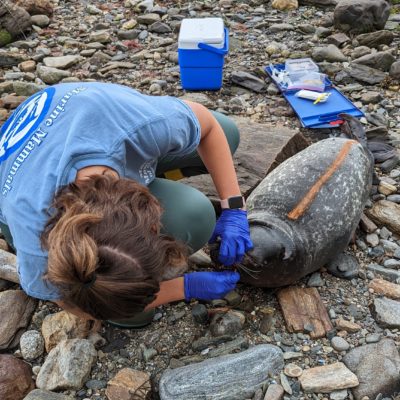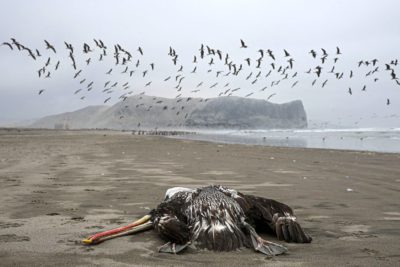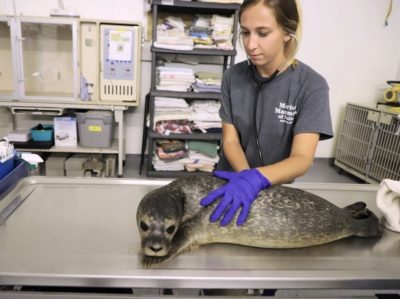Last June, the phones at Marine Mammals of Maine began ringing — a lot. People walking the craggy shoreline of Casco Bay, which stretches north and south of Portland, were reporting sick or dead seals. Late spring and early summer, as pups begin to set off on their own, are usually the rescue and rehabilitation center’s busiest time, but the volume of calls kept increasing. “We were dealing with three times the number of animals we would normally be dealing with,” says Lynda Doughty, the center’s executive director.
One harbor seal’s behavior stood out. The animal was, Doughty recalls, “neurologic” — its weight and overall nutrition were fine, but in addition to coughing and sneezing, it was twitching and seemed disorientated. The young male’s condition was rapidly declining, and Doughty’s thoughts turned to the many recent reports of wild birds — like raptors and gulls — infected with a new strain of H5N1, a highly contagious avian influenza. She worried that whatever ailed the rapidly declining seal could spread to the other seals crowding the center and made the difficult decision to euthanize. Then she called Wendy Puryear.
Avian influenza previously didn’t appear to spread between mammals. But this new variant has proven different.
When Marine Mammals of Maine has a dead animal whose illness cannot be identified following a gross necropsy, it often sends tissue samples to Puryear, a molecular virologist at Tufts University whose recent research has focused on how avian influenza moves from birds to mammals and then to other mammals. At the university’s Runstadler Lab, Puryear and her team ran PCR tests on swab samples from the seal. When they came back positive, the team overnighted a sample to a federal lab for confirmation. “I needed to make absolutely sure of the results before I sounded the alarms,” Puryear says, “because I anticipated all of the big wheels that would immediately be put in motion.”
It was the world’s first confirmed case of this latest, extremely virulent strain of H5N1 in marine mammals, and it wouldn’t be the last. By the end of July, more than 330 harbor and gray seals had died from the virus — enough that the National Marine Fisheries Service immediately declared an “unusual mortality event” for pinnipeds along the Maine coast. In the months that followed, it became clear that H5N1 was hardly contained to North America. Infections in seals and sea lions have since been confirmed in Europe, Russia, and South America. The most severe die-off was of more than 3,000 sea lions in Peru this winter.
A member of the Marine Mammals of Maine response team swabs a harbor seal to test for avian influenza.
Marine Mammals of Maine
Avian influenza viruses are classified as either low or highly pathogenic, based on how lethal they are to poultry, and some “low path” strains can mutate into “high path” influenzas. The current variant of H5N1 is one of the most virulent high path avian influenzas ever documented, experts say. It originated in farmed geese in Guangdong, China in 1996, and by 2005 wild birds were spreading the virus in Africa, the Middle East, and Europe.
Last year, Puryear was a coauthor on a study led by Nichola Hill, a University of Massachusetts-Boston biologist, that examined how migrating seabirds, like gulls, have played a significant role in spreading H5N1. In a briefing with reporters last month, Hill noted that the first detection occurred in December 2021, in Newfoundland, when a great black-backed gull and poultry at a noncommercial farm became infected at about the same time. The disease has since killed nearly 59 million poultry and 6,715 wild birds across the U.S., including endangered species like the sandhill crane and the California condor. According to Hill, estimates of global wild bird mortality range from 10,000 to a million individuals.
Just one year after the 1996 Guangdong outbreak, H5N1 reached Hong Kong, where it was detected in humans for the first time: 18 people were infected and six died. Though there have been only 890 human cases since the Hong Kong outbreak, the virus has a fatality rate of 50 percent, according to the Centers for Disease Control. What kept H5N1 from infecting more people is that it didn’t appear to spread between mammals: it moved only from bird to mammal through direct contact with body fluids or feathers. But this new variant has proven different. When it raced through a mink farm in Spain last October — triggering the euthanization of the facility’s 50,000 animals — the question of whether H5N1 could spread between mammals was answered. “I think a large, looming question for a lot of us is, ‘Do these latest outbreaks represent a new era for bird flu?’” Hill said in the briefing. “And the answer is yes.”
Several recent cases in other parts of the world illustrate how little is known about H5N1 in marine mammals.
Puryear and Hill are among a cadre of scientists and researchers in the Gulf of Maine region who have been watching the evolution of avian influenza infection in marine mammals since 2011, when the variant H3N8 killed 162 young harbor seals in Maine, New Hampshire, and Massachusetts. In fact, there have been periodic outbreaks of avian influenza in seals in the Americas and Eurasia going back to at least 1972. It had generally been assumed that those were bird-to-seal events, or one-off “dead-end spillovers,” which don’t spread between mammals. But after the 2011 die-off, Puryear, Hill, and other colleagues decided to test that assumption. Was influenza “out there circulating in marine mammals as well?” Puryear asked.
To gather data on as many marine mammals as possible, the researchers teamed up with NOAA’s Marine Mammal Health and Stranding Response Program, which includes a network of small rescue and rehabilitation centers. Through collaboration with Doughty and her team, Puryear was able to obtain fluid, tissue, or swab samples from every reported seal stranding in Maine, both alive and deceased. That data, combined with those compiled from three years’ worth of site visits to gray seal rookeries, where health assessments were performed on more than 300 animals, allowed the researchers to determine that — in gray seals, at least — low path avian influenza infection is in fact not restricted to spillover events.
“What we found is it’s pretty much always there,” Puryear says. “There wasn’t a year that we didn’t pick up influenza in the gray seals, going all the way back to 2012.” Like the common cold perpetually circulating among first graders, low-path avian influenza circulates more or less continuously among gray seals, which makes them more vulnerable to dangerous high-path variants. That understanding, Puryear continues, made it “not at all surprising when H5N1 made its way [from birds] into the seals” last year.
A pelican believed to have died from avian influenza on a beach in Lima, Peru in December.
ERNESTO BENAVIDES / AFP via Getty Images
Deborah Fauquier, a veterinary medical officer with the National Marine Mammal Health and Stranding Response Program, says that, as of now, it appears that last summer’s outbreak of H5N1 in Maine resulted from bird-to-seal transmission, not mammal to mammal. “We’ve been continually testing, and we haven’t seen a positive since July 15,” Fauquier says. “So at the moment it seems to be these very perfect storms, where you have really sick birds near seals that are congregating, and we’re getting these individual spillover events.”
Several recent cases in other parts of the world, however, illustrate how little is known about H5N1 in marine mammals. By the end of 2022, the variant was circulating widely in South America but especially in Peru, where the death toll of wild birds eventually reached 50,000, according to some researchers. Then, from January through February of this year, more than 3,000 sea lions fell sick and died. On Isla San Gallán alone, 1,112 individuals, many of them pregnant females, perished. Many of the sea lions necropsied tested positive for H5N1. Because of the high number of deaths in such a short time, and with studies suggesting the virus had spread between minks in Spain, researchers concluded, “we cannot rule out that the virus has adapted to mammals and that sea lion-sea lion transmission has begun in Peru.”
Puryear says that there are most likely two explanations for these outbreaks in such high concentrations of marine mammals. The first is that there’s a very low “species barrier” between birds and seals, and that with such a large number of infected wild birds at the moment, there is “lots of virus being shed and available for large numbers of unique parallel infections.” The second explanation, she says, is that there is “at least some degree of transmission occurring between the mammals themselves, as described with the mink.”
The first known case of avian influenza in a cetacean was found in a dead bottlenose dolphin in Florida last March.
Such an escalation in H5N1’s virality in mammals would mark a frightening new chapter in the evolution of avian influenza, and scientists like Hill and Fauquier reiterate that the evidence still isn’t there. Hill has since reviewed the H5N1 sequences taken from some of the Peruvian sea lion tissue samples. “When we look at the genetics of the virus, it’s not telling us that we have achieved mammal to mammal transmission yet,” she said in the April briefing with reporters. Nevertheless, she added, “All eyes are on the Peru and other South America outbreaks that are going on right now.”
A similar mass mortality event seems to have occurred near Dagestan, Russia in December. Though little is known yet about the outbreak, reports from Russian media indicate that about 700 Caspian seals died that month, according to the infectious disease blog Avian Flu Diary. One blog post included a press release by Dagestan State University that confirmed that some of the seals had tested positive for “avian influenza.” Though it was too early to conclude that the virus caused the die-off, Alimurad Gadzhiev, the director of the university’s Institute of Ecology and Sustainable Development, noted that H5N1 had been responsible for a mass wild bird die-off on a nearby island in early summer.
Because of past avian influenza infections documented in seals and sea lions, these recent die-offs are not unexpected, considering how contagious and virulent H5N1 is. Recent reports of cetacean infections, however, are troubling. The first known case was detected in a dead bottlenose dolphin found in Florida last March. Then a harbor porpoise in Sweden tested positive in June. This past February, two dolphins in the United Kingdom died of the virus.
For now, Fauquier says, the sporadic, one-off nature of these dolphin strandings shows that the virus is still not that effective in spreading between cetaceans. “We have tested dolphins and whales on and off for influenza in general, and I don’t know if I’ve ever had a positive for low path ever,” she says. “It’s just not a very common thing.”
It’s also reassuring, Fauquier adds, that there have not been any positive H5N1 infections in Maine seals so far this year. If no new cases emerge during this year’s pupping season, which is underway, Fauquier and her colleagues at the National Marine Mammal Health and Stranding Response Program recommend closing the unusual mortality event (UME) declaration, which would stop active investigation by the program’s working group, as well as some federal funding. But, Fauquier says, “we’ll continue to monitor even if the UME closes, because we want to make sure that, if it becomes seal-to-seal, we’ll know that right away.”
If H5N1 resurfaces in the Gulf of Maine this spring, Doughty will likely handle the first infected seal. The outbreaks of the past have taught her to expect the unexpected and to react quickly when her instincts tell her something serious is on the horizon. “Because birds don’t stop flying their migrations, and seals don’t stop swimming in the Gulf of Maine and through the Northwest Atlantic,” Doughty says. “We need to be on alert every year now — what may be the next new strain?”



